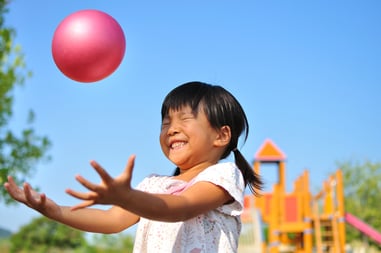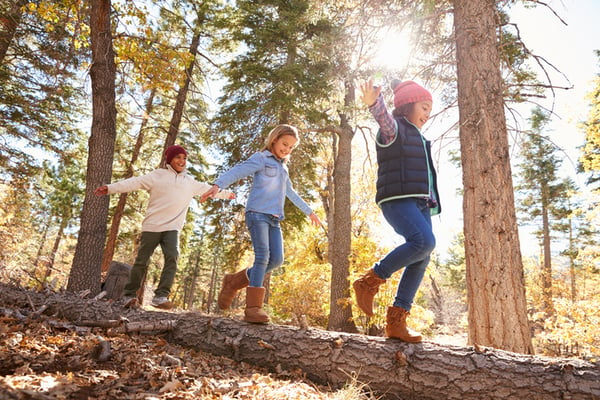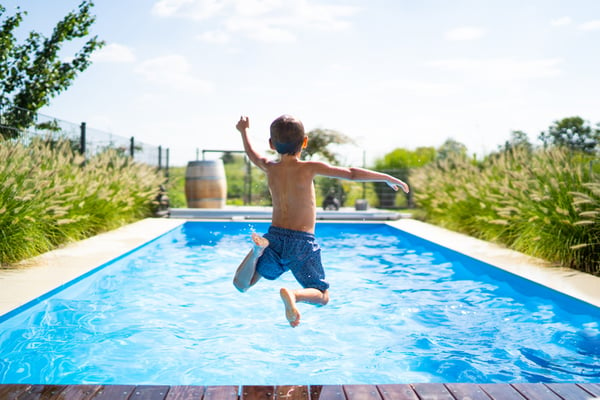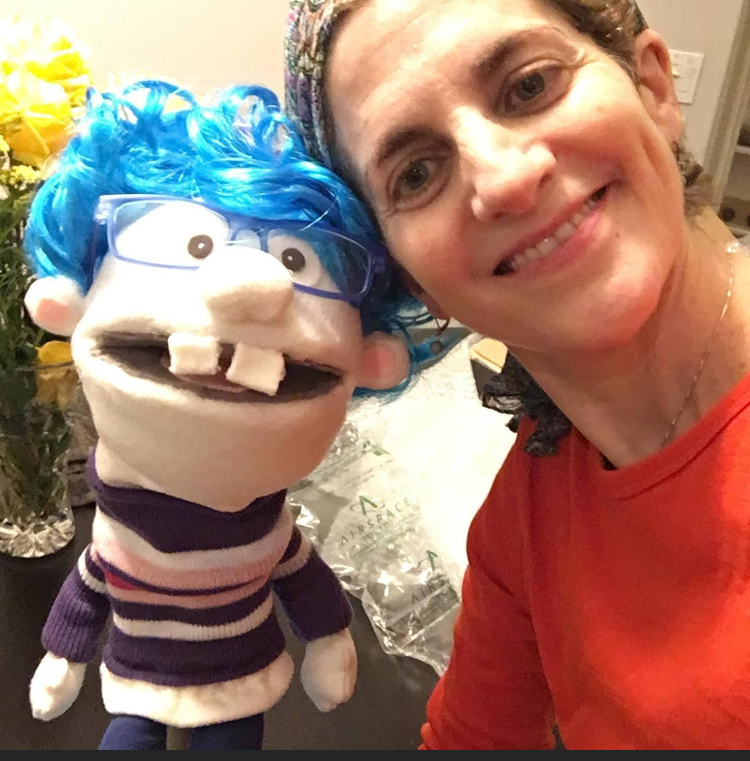10 Gross Motor Skills for Your Autistic Child
Gross Motor Skills 101
Ready, set, let’s go! Walk, run, jump, swim, climb. There are so many ways we can move our bodies. Gross motor skills are those skills that we need to move, skills that are designed to help us survive, but also to thrive. As a baby develops they learn to roll, crawl, kneel, stand, and walk. A young child will then learn to climb, jump, run, kick, and throw. As we continue to develop we can learn skills such as dancing, hiking, running, swimming, or other sports. And the best part is that we can continue developing these skills throughout our lives. For autistic or other special needs children, new skills may take more effort and time.
Read on for some ideas and take a look at the ARIS® Academic Readiness Intervention System curriculum's free Lesson to use for gross motor development: Jumping & Hopping.
The Benefits of Gross Motor Skills
“But my child doesn’t like to do much. He just likes his iPad.” This is a common remark, which is why it is so important to begin gross motor skills training as early as possible with as much consistency as possible. The benefits of motion outweigh the comforts of a couch and the temporary calm induced by video or electronics (though they too have their time and benefits). Benefits of gross motor skills may include:
-
As we move, “happy chemicals” are released otherwise known as endorphins. Learning new skills also makes our brains more pliable and more adaptable to new information. Every time we move synapses are formed and our brain is literally rewired! A Healthier Brain:
A Healthier Brain: -
Coordination:
When we move we use both sides of the brain which improves our coordination and ability to cross midline (middle of the body) providing us with better balance, hand-eye coordination, and accuracy. -
Healthier Body:
Learning motor skills means better muscle tone, a more regular heart rate, respiration, blood pressure, and better bone density. It also improves our chances of having fewer injuries. -
Better Social Skills:
Being able to engage with others through movement means we can socialize with more ease, which in turn improves our self-esteem and yes, improves that happy factor.
Gross Motor Skills Ideas
Below are a few ideas for developing children that might help you come up with some of your own! Don’t be shy and get ready to not only move with your kids but share a few laughs. Oh, and don’t forget, losing balance is a great way to gain it. So, though we encourage safety, we also encourage challenging your children as they move.
-
Let’s Play Ball!
Kids and balls go together. An 8”-10” tactile playground ball has a nice bounce, a textured surface, and a bit of weight providing good proprioceptive feedback (joint and muscle awareness). Rolling the ball, bouncing, bounce-catch, or tossing into a target make for a great activity. Start slow and close and repeat, repeat, repeat! You can also use much smaller balls like tennis balls or handballs for tossing as well. As kids get older try tossing with the right hand and then catching with the left. Now switch! Keep your target or partner close by (just a couple of feet away) to start. You can also get a small parachute or even a sheet and place a beach ball or other balls onto it and make it pop around by having everyone wave the parachute up and down. This requires 3-4 people working together. Hiding a ball and finding it is a fun game too. Bounce for fun!
-
Use Your Wall
We spend much time on the floor, sitting on a chair, or lounging on a couch. Use your wall to get your kids up and moving. You can place a large piece of paper for art, a magnetic or wipe-erase board, tactile materials, spots, or targets on your wall. Do you have a favorite activity or game? You might be able to adhere it to the wall. Now your kids will stand up and use their upper body and core to play. The wall also makes a great place to do modified pushups! Just lean toward the wall and push back away. Can you push and clap? -
Ride-on Toy
A ride-on toy works the legs, core, and yes, even the arms. When children are first learning, a ride-on toy with a narrow seat and low to the ground is great for learning to balance and walk. As they get older a trike with pedals is ideal followed by a balance bike and then a standard bike. Adapted bikes are available for children through adults who need more support. Just be sure everyone is equipped with a helmet! -
Take a Wild Walk
Turn your floor into a spacewalk with pillows. Kids love obstacle courses, and you can use blocks, pillows, Hoola Hoops, and carpet squares to create a walking obstacle course. Take it outside and use inner tubes and logs for stepping in and out, up and over. A hike in the woods makes a great sensory-motor outing that works the entire body from your senses to your muscles challenging your balance and endurance.

-
Feel the Rhythm
Music is the ideal companion for encouraging motor skills. You can use your own music, videos, voice, or musical instruments to encourage learning body parts, stepping, balancing, jumping, and dancing. Basic songs like “head-shoulders-knees-and-toes” are great for younger children; whereas, more popular music can be perfect for older tweens and teens.
-
Build It for Your Body
Building something uses the entire body. For little ones, blocks are great for getting started. As children get older, Legos® and other more advanced systems can be used. A workbench can be used for older tweens and teens to learn to build things like a simple birdhouse. The more active the kids are, the better. Even technology like robotics and coding can be combined with building, providing a whole-body learning experience.
-
Up Up and Away
Swinging has so many benefits including calming, hard work, and a keen vestibular system. A swing can be hung from a doorway, rafters, inside or outside. You can install a hammock or platform swing depending on whether you want a calm or hard work experience for the body. A single-point swing can make for a great spin; whereas, a two-point swing can work the core as you learn to hold on, pump, and control the swing. Swinging has a way of encouraging speech and language skills too. Who doesn’t want to sing and swing?
-
Get Wet
Water is a terrific tool for encouraging motor skills. When children are small, stepping up to the sink on a stool can provide a great activity such as washing hands and cups, and making bubbles. As children get older a warm rainy day is a great time to fill buckets, play under an umbrella, and even learn to sweep the water with a broom. Swim lessons and playing in a swimming pool provide a full-body activity with physical, social, and mental benefits. No pool? Maybe your kids can help you wash your car!
-
Yoga for Kids
There are plenty of opportunities to find online yoga classes and programs for children. Yoga is a form of mind-body exercise that encourages strength, balance, and flexibility. It also improves focus and attention. Look for a program that is open to children with differing abilities and one that is engaging. If your child does not like yoga, you can try dance, karate, or other individual sports. No yoga access? Try acting out different animal positions. You can use animal poses to enhance your animal curriculum.
-
Jump for Fun!
Learning to jump, run, skip, and hop are important developmental skills. Try to break these skills down into pieces for children who struggle while learning how to do them. One fun idea is to put 3 to 4 ropes out on the ground and have kids step over them, being sure not to step on them. You can keep spreading them further apart until they have to run and leap to get over them.

There are many accessible and fun activities for children and adults of all ages to participate in that encourage the development of gross motor skills. Remember, fun, focus, consistency, and safety are key, not perfection. With that said, keep an eye on positions and posture and if needed, consult with a physical therapist. Be creative, use counting, music, or mnemonics to help your children stay on task, focused, and engaged.
Gross Motor Skills Milestones
Listed below are typical gross motor skill milestones by age. Keep in mind that this can vary from child to child and though we have suggested skills through age 5, motor and sports skills can continue to develop throughout the life span.
-
Age 0-6 months:
Rolling front to back and back to front, sitting with or without support -
Age 6-12 months:
Independent sitting, crawling, transitions from the floor to sitting, pulling up to stand from sitting through kneeling, side-stepping (cruising), independent standing, walking -
Age 1-2 years:
Squatting, walking up and down hills/steps/on grass, holding a rail or hand, running (though may fall easily), rolling/tossing/kicking a ball -
Age 2-3 years:
Climbing steps without a handrail, jumping, running more efficiently, catching a large ball -
Age 3-4 years:
Balance on 1 foot, broad jump, ride a tricycle -
Age 4-5 years:
Skip, ride a balance bike, somersault, play catch with a medium-sized ball, strike at ball with a bat, learn to swim -
Age 5-6 years:
Jump rope, learn to skate, begin to play ball sports, or learn individual sports such as karate, gymnastics, running, or hiking

Ilana Danneman, PT
Ilana (or “Miss Ilana” as her clients refer to her) is a pediatric physical therapist and the owner of Special Needs in Motion. She works in Atlanta, Georgia and produces a bimonthly special needs podcast for parents, teachers and therapists. Ilana enjoys, writing, walking, biking, working with special needs children and their families and podcasting!






